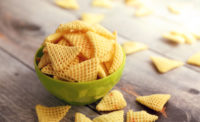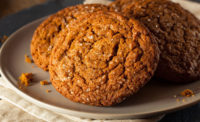The extruded snacks market has significantly expanded in recent years as more manufacturers capitalize on innovations to create unique offerings. Dynamic twin-screw extrusion barrel and die designs—along with a revitalization in co-extrusion techniques—have helped bring a wide range of new products onto the market to join the ranks of well-known category staples.
Consumers and snack manufacturers have begun showing interest in more-sophisticated products like co-extruded (filled) snacks, says Mike Shaw, sales account manager, extrusion, Buhler Inc., Minneapolis. In the breakfast cereal category (products that often are consumed as snacks), Kellogg’s Krave is a perfect example.
“The co-extrusion technology has been around for a long time, but this product type has gained momentum in the market recently,” says Shaw. “It can be presented as a sweet or savory type of snack, with the traditional product line distinctions being blurred between snack, cookie, cracker and cereal.”
This diversity gives snack manufacturers a wide field of play to see what resonates with consumers. “The flexibility of twin-screw extrusion technology allows manufacturers to adjust a number of parameters in the extruder to achieve different eating characteristics,” says Shaw. “This is a significant benefit in using a twin-screw extrusion. Screw configuration, screw speed, injection of liquids and/or steam, die design and a number of other factors can be configured to give the appropriate amount of thermal and/or mechanical cooking to achieve a wide range of end-product attributes.”
“Extrusion technology continues to develop, and this has enabled a variety of exciting applications,” says Don Trouba, director, marketing, Ardent Mills, Omaha, NE. “Whether it’s multicolored co-extruded foods, complex dies for expanded and unexpanded products, or production efficiency, the forms and varieties of foods that today’s extruders can produce allow for a variety of foods for people of all ages and interests.”
This has yielded more third-generation (3G) products—also known as “half products” (multidimensional products subsequently puffed, popped or fried)—notes Chad Rieschl, senior research technologist, Cargill, Minneapolis.
While Rieschl says that second-generation, direct-expanded products “create new and unique eating experiences, the 3G-type products are now pushing the envelope even further. A 3G snack made with the same formula may provide a different eating experience, depending on how the product is indirectly puffed (hot air, microwave, oil, etc.).”
Rieschl suggests that much of the innovation in extruded snacks has resulted from strong R&D and ingredient experimentation. “Snack producers are seeing the advantages that twin-screw can bring by leveraging existing technologies that allow them to create unique items with various types of ingredients,” he says.
A pronounced nutritional push has catalyzed use of new ingredients. “Extruded snacks have become ‘better for you,’ with enhancements in raw ingredients such as different grains, ancient grains, legumes and certain vegetables,” says Jeff Roberts, marketing and business development, Snak King, City of Industry, CA.
“Extrusion lends the opportunity to have the snack baked, instead of fried, which leads to less fat content and thus a better nutritional profile,” says Roberts. “Extruded snacks also work well with multiple different grain choices, as well as with whole grain opportunities that boost nutritional value. When you start with ‘smart’ ingredients, you end up with healthier, more beneficial snacks.”
Fundamental strength
Kings of the extruded snacks world, cheese snacks continue to show reliable performance. IRI, Chicago, reports that the category is up 4.81 percent in dollar sales for the 52 weeks ending Oct. 5, 2014, to $1.81 billion. Frito-Lay, the undisputed leader of the category—with its iconic Cheetos brand—was at $1.55 billion for the period.
Frito-Lay’s Funyuns line was also on the upswing for the period, posting a gain of 3.11 percent in dollar share for $315.16 million in sales. Chile Limón is the line’s newest flavor, added in 2013.
Pirate’s Booty, a B&G Foods product, sold well during the period, up 4.33 percent in dollar sales and hitting $67.24 million. The product lineup now includes Crunchy Treasures, featuring a diversity of pirate-themed corn puff shapes, and Fruity Booty, which has a raspberry flavor.
While these quintessential extruded snack brands continue to show strength, they have all seen line extensions through the years to diversify their appeal—sometimes by joining forces, as seen in the Flamin’ Hot Cheetos and Doritos Dinamita Chile Limón rolled tortilla chips (also a Frito-Lay brand) two-in-one product released in 2014.
But in an industry that provides ongoing discourse on wellness trends, these leading brands remain unequivocally—and unapologetically—indulgent.
Walk the line
Nevertheless, a market for snacks that inch closer toward health and wellness has emerged.
Many types of puffed snack nuggets, often made from corn, that have been hitting the market lately walk a nicely balanced line between better-for-you and indulgent. The light, simple nature of the puffs helps offset sweet coatings coming into favor, like caramel and chocolate, thereby achieving a craveable balance that doesn’t seem overly indulgent.
Utz makes Caramel Puff’n Corn. KLN Family Brands offers Barrel O’ Fun Caramel Pops. Lehi Valley has its Arizona Snack Co. Golden Caramel Corn Nuggets, as well as its The Amazingly Wondrous Nuggets brand of The Natural Wonders (corn puffs coated in butter toffee).
Many similar products are also on the scene—and more are coming, some taking a decidedly upscale and adult bent. This month, upstart Sir Charles LLC will launch its sweet-salty Pop-Stoppers, a co-extruded puffed corn snack, in four flavors: White Chocolate, Milk Chocolate, Peanut Butter and Dark Chocolate. These all-natural snacks do not contain artificial ingredients and are gluten-free. Meyer Futersak, CEO of the company, notes that the products also use fair trade ingredients.
Manufacturers could also build momentum by creating puffed products coated with flavored yogurt, ideally with active probiotic cultures. IRI reports that yogurt-coated pretzels and nuts continue to perform quite well, and the category was responsible for $120.76 million in sales for the period.
Veggie straws are perfect example of a product that caters to consumer demographics opting for better-for-you snacks—and the key here is “better-for-you.” These products are designed to help consumers make incrementally positive steps toward improved nutrition. Sensible Portions Veggie Straws, a Hain Celestial brand, saw 137.11 percent growth in dollar sales for the period, with $45.42 million in sales.
Clean-label criteria are often a factor with these snacks. Brett Hartmann, snacks category manager, The Hain Celestial Group Inc., Lake Success, NY, notes that the Sensible Portions Garden Veggie Chips and Straws do not contain any artificial preservatives or flavors, and are made with non-GMO ingredients. “They are made with real vegetables in varying combinations of potatoes, tomatoes, spinach and sweet potato,” he says, noting that the products contain 30 percent less fat per serving than the leading potato chips. Available flavors include Cheddar and Ranch. “Also, new stackable Veggie Chips are now available at Walmart in BBQ, Cheddar Cheese, Sour Cream & Onion and Sea Salt,” he says.
Popped chips made from half products are also changing the extruded snacks market. Allen Benz, chief snackologist, Snack Innovations, Brooklyn, NY, notes that his company developed its Slim Chips using extruded intermediate snack pellets in a hot-air pop process as opposed to frying. “The process utilizes indirect heat and a fluidized hot-air bed,” he says. “Our proprietary process yields low-fat, low-calorie snack products that are light and crunchy.” The company also makes Smart Fries (air-popped potato sticks) and Pop Rings (air-popped onion rings).
And although wheat is not foreign to extruded snacks, a powerful opportunity within the segment is the wide range of options of suitable gluten-free substrates, including corn, rice and potato, as well as a wide variety of ancient grains. “The market continues to focus on healthy snacking, utilizing a wider range of raw materials with particular focus on gluten-free ingredients,” notes Shaw.
Smart Fries originally had wheat in the formula, notes Benz, but the company made the move to go gluten-free. “Developing our Smart Fries into a gluten-free product was a long and vigorous process,” he says. This involved much due diligence across the supply chain. The wheat in the original formula had a pronounced impact on the expansion process—and on the finished product in regard to taste and mouthfeel, he notes. But the team eventually developed a formula that improved upon the original eating characteristics, resulting in a gluten-free and non-GMO product.
Next steps
Growth in this segment continues to come partially from expanding technological capabilities. “Extruder ancillary equipment can be attached to a base extruder to offer added flexibility in providing different snack forms, textures and eating characteristics,” says Shaw. “This allows a snack manufacturer to react quickly to respond to market demands and trends using their existing base extruder technology.”
Interesting approaches to extrusion and formulation are yielding an ever-expanding range of shapes and textures. Some new items of note include:
- Swurves—oblong, curved, ridged corn chips in flavors like Asian Fusion and Tuscan Kitchen from Leo Street Creations
- Chip’ins—triangular, popcorn-based chips from Popcorn, Indiana
- Slim Chips—circular “popcorn chips” made from corn, quinoa, flax, chia and sunflower seeds from Gourmet Basics/Snack Innovations Inc.
- Life Choice brand Delight Bites—honeycomb-styled puffed snacks from ConAgra Foods
Better-for-you characteristics will continue to drive extruded snacks forward. Rieschl sees the “continued desire by consumers for manufacturers to use label-friendly ingredients, whole grains, nonallergenic protein sources and natural fiber sources, all while delivering unique textures and flavors” as key to this evolution.
“Although the growth in snacking has been a powerful driver for extruded foods, one area that hasn’t kept pace has been the nutritional profile of many items, particularly with regard to whole grains and fiber,” says Trouba. He notes that although formulating high levels of fiber into snacks has proved challenging in the past, new ingredients, such as the company’s high-fiber barley ingredient and white whole-wheat flour, can seamlessly build high levels of fiber and whole grains into snacks. “Continuing improvements in technology and the wider availability of whole grains makes this a part of extrusion that can now grow,” he says.
In terms of possible product formats, manufacturers have only begun to scratch the surface with extruded snacks. “Don’t let fear of the unknown hold you back,” says Rieschl. “With the twin-screw, so many changes can be made to manipulate flavor and texture.”
Better-for-you snacking is part of a greater evolution across food at large. “Overall, consumers are just more aware of what is better for them than not,” says Roberts. “We are seeing this trend with people who are making smarter decisions for what they eat for the ‘center of the plate,’ and that is simply transitioning to decisions made for snacks. In this busy world, people are also snacking more in general, because they are on the go or don’t have time to sit for a good meal. So they replace those occasions with snacks that don’t simply just fill them up with empty nutrition, but with snacks that add nutritional value and still taste great.”








